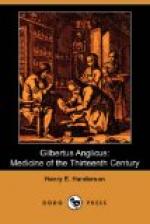Gilbert’s sections on goitre (bocium gulae)[8] are interesting in themselves, and characteristic of the method adopted by him in his discussion of surgical or semi-surgical subjects. An introduction relative to the pathology of the disease and which seems to be original, is followed by a treatment, medical and surgical, adopted almost literally from the Chirurgia of Roger. Thus he says: “Goiter occurs most commonly among the inhabitants of mountainous regions, and is due to an amplification and dilatation of the veins, arteries and nerves, together with the soft tissues, occasioned by the north wind (ventum boreale), or some other confined wind, which during childhood has accumulated in (coadunabatur) and enlarged the part to the size of the goiter.” After suggesting an analogy between the disease and the redness and turgidity of the neck produced by passion or in singing, he adds that some cases are due to an accumulation of spongy tissue between the veins and arteries, or to the use of flatulent food, and he even tells us that some old women know how to produce and remove goitrous swellings by means of certain suitable herbs known to them.
[Footnote 8: Cf. the French bosse de la gorge.]
Under medical treatment we find the following: “Dig out of the ground while chanting a pater noster, a nut which has never borne fruit. The roots and other parts pound well with two hundred grains of pepper, and boil down in the best wine until reduced in volume to one-half. Let the patient take this freely on an empty stomach until cured.”
Another more elaborate prescription consists of a long list of ingredients, including burnt sponge, saponaria, the milk of a sow raising her first litter, with numerous simple herbs, and the sole object for which this nonsensical farrago is introduced here is to add that both these prescriptions are copied from the surgery of Roger. It is important too to remark here that we owe to Roger the introduction of iodine, under the form of burnt sponge, into the treatment of goiter.
In the failure of medical treatment, Gilbert directs the employment of surgical means, e.g., the use of setons, or, in suitable cases, extirpation of the goiter with the knife. If, however, the tumor is very vascular, he prefers to leave the case to nature rather than expose the patient to the dangers of a bloody operation. The whole discussion of goiter is manifestly a paraphrase of the similar chapter of Roger, who also introduced into surgical practice the use of the seton.
In Gilbert’s chapter entitled “De arthretica passione et ejus speciebus,” we are introduced to the earliest discussion by an English physician of that preeminently English disease—gout. We may infer, too, from the length of the discussion (thirty or more pages) that this was a disease with which Gilbert was not only familiar, but upon the knowledge of which he prided himself greatly. Indeed, it is one of the few diseases of the Compendium in which the author assumes the position of a clinician and introduces examples of the disease and its treatment taken from his own clientele. We shall, therefore, follow our author here rather more carefully and literally than usual, that we may learn the views of an English physician of the thirteenth century on, perhaps, the most characteristic disease of his countrymen.




